β-Phosphonated Glycine Pendant Groups Grafted on Styrene-6.7% Divinylbenzene Copolymers: Synthesis and Their Application as Photocatalysts
Abstract
:Featured Application
Abstract
1. Introduction
2. Materials and Methods
2.1. Materials
2.2. Obtaining of β-Phosphonated Glycine Pendant Groups Grafted on Styrene-6.7% Divinylbenzene Copolymers
2.3. Application as Photocatalysts for Congo Red Dye Removal
2.4. Characterization Methods
3. Results and Discussions
3.1. Samples Characterization
3.2. Photocatalysis for Congo Red Dye Removal
3.2.1. Dark Adsorption Studies
3.2.2. Efficiency of Photocatalysts
3.2.3. Influence of Congo Red Initial Concentration
3.2.4. Influence of Solid Catalyst Amount
3.2.5. Kinetics of Photocatalysis
3.2.6. Structural Changes in CR Molecule during Photocatalysis
3.2.7. Reusability of the Catalysts
4. Conclusions
Author Contributions
Funding
Institutional Review Board Statement
Informed Consent Statement
Data Availability Statement
Conflicts of Interest
References
- Nasar, A.; Mashkoor, F. Application of polyaniline-based adsorbents for dye removal from water and wastewater—A review. Environ. Sci. Pollut. Res. 2019, 26, 5333–5356. [Google Scholar] [CrossRef] [PubMed]
- Tkaczyk, A.; Mitrowska, K.; Posyniak, A. Synthetic organic dyes as contaminants of the aquatic environment and their implications for ecosystems: A review. Sci. Total Environ. 2020, 717, 137222. [Google Scholar] [CrossRef] [PubMed]
- Kant, R. Textile dyeing industry an environmental hazard. Nat. Sci. 2012, 4, 22–26. [Google Scholar] [CrossRef]
- Holkar, C.R.; Jadhav, A.J.; Pinjari, D.V.; Mahamuni, N.M.; Pandit, A.B. A critical review on textile wastewater treatments: Possible approaches. J. Environ. Manag. 2016, 182, 351–366. [Google Scholar] [CrossRef]
- Adane, T.; Adugna, A.T.; Alemayehu, E. Textile Industry Effluent Treatment Techniques. J. Chem. 2021, 2021, 5314404. [Google Scholar] [CrossRef]
- Mirza, N.R.; Huang, R.; Du, E.; Peng, M.; Pan, Z.; Ding, H.; Shan, G.; Ling, L.; Xie, Z. A review of the textile wastewater treatment technologies with special focus on advanced oxidation processes (AOPs), membrane separation and integrated AOP-membrane processes. Desalination Water Treat. 2020, 206, 83–107. [Google Scholar] [CrossRef]
- Maranescu, B.; Lupa, L.; Visa, A. Heavy metal removal from waste waters by phosphonate metal organic frameworks. Pure Appl. Chem. 2018, 90, 35–47. [Google Scholar] [CrossRef]
- Lupa, L.; Maranescu, B.; Visa, A. Equilibrium and kinetic studies of chromium ions adsorption on Co(II) based phosphonate metal organic frameworks. Sep. Sci. Technol. 2018, 53, 1017–1026. [Google Scholar] [CrossRef]
- Miklos, D.B.; Remy, C.; Jekel, M.; Linden, K.G.; Drewes, J.E.; Hübner, U. Evaluation of advanced oxidation processes for water and wastewater treatment—A critical review. Water Res. 2018, 139, 118–131. [Google Scholar] [CrossRef]
- Bolton, J.R.; Bircher, K.G.; Tumas, W.; Tolman, C.A. Figures-of-merit for the technical development and application of advanced oxidation technologies for both electric- and solar-driven systems (IUPAC Technical Report). Pure Appl. Chem. 2001, 73, 627–637. [Google Scholar] [CrossRef]
- Thota, S.; Tirukkovalluri, S.R.; Bojja, S. Visible light induced photocatalytic degradation of methyl red with codoped titania. J. Catal. 2014, 2014, 962419. [Google Scholar] [CrossRef]
- Andronic, L.; Isac, L.; Cazan, C.; Enesca, A. Simultaneous Adsorption and Photocatalysis Processes Based on Ternary TiO2–CuxS–Fly Ash Hetero-Structures. Appl. Sci. 2020, 10, 8070. [Google Scholar] [CrossRef]
- Dvininov, E.; Popovici, E.; Pode, R.; Cocheci, L.; Barvinschi, P.; Nica, V. Synthesis and characterization of TiO2-pillared Romanian clay and their application for azoic dyes photodegradation. J. Hazard. Mater. 2009, 167, 1050–1056. [Google Scholar] [CrossRef]
- Velmurugan, R.; Swaminathan, M. An efficient nanostructured ZnO for dye sensitized degradation of reactive red 120 dye under solar light. Sol. Energ. Mat. Sol. C 2011, 95, 942–950. [Google Scholar] [CrossRef]
- Salem, I.A.; El-Ghamry, H.A.; El-Ghobashy, M.A. Catalytic decolorization of Acid blue 29 dye by H2O2 and a heterogeneous catalyst. Beni-Suef Univ. J. Basic Appl. Sci. 2014, 3, 186–192. [Google Scholar] [CrossRef]
- Golban, A.; Cocheci, L.; Lazau, R.; Lupa, L.; Pode, R. Iron ions reclaiming from sludge resulted from hot-dip galvanizing process, as Mg3 Fe-layered double hydroxide used in the degradation process of organic dyes. Desalination Water Treat. 2018, 131, 317–327. [Google Scholar] [CrossRef]
- Sarkar, S.; Ponce, N.T.; Banerjee, A.; Bandopadhyay, R.; Rajendran, S.; Lichtfouse, E. Green polymeric nanomaterials for the photocatalytic degradation of dyes: A review. Environ. Chem. Lett. 2020, 18, 1569–1580. [Google Scholar] [CrossRef]
- Orooji, Y.; Akbari, R.; Nezafat, Z.; Nasrollahzadeh, M.; Kamali, T.A. Recent signs of progress in polymer-supported silver complexes/nanoparticles for remediation of environmental pollutants. J. Mol. Liq. 2021, 329, 115583. [Google Scholar] [CrossRef]
- Shilpa, E.R.; Gayathri, V. Polymer immobilized Fe(III) complex of 2-phenylbenzimidazole: An efficient catalyst for photodegradation of dyes under UV/Visible light irradiation. J. Saudi Chem. Soc. 2018, 22, 678–691. [Google Scholar] [CrossRef]
- Davidescu, C.M.; Ardelean, R.; Popa, A. Performance of poly(styrene-co-divinylbenzene) functionalized with different aminophosphonate pendant groups, in the removal of phenolic compounds from aqueous solutions. Pure Appl. Chem. 2016, 88, 993–1004. [Google Scholar] [CrossRef]
- Popa, A.; Ene, R.; Visinescu, D.; Dragan, E.S.; Ilia, G.; Iliescu, S.; Parvulescu, V. Transitional metals immobilized by coordination on aminophosphonate functionalized copolymers and their catalytic properties. J. Mol. Catal. A-Chem. 2015, 408, 262–270. [Google Scholar] [CrossRef]
- Amin, P.O.; Ketuly, K.A.; Saeed, S.R.; Muhammadsharif, F.F.; Symes, M.D.; Paul, A.; Sulaiman, K. Synthesis, spectroscopic, electrochemical and photophysical properties of high band gap polymers for potential applications in semi-transparent solar cells. BMC Chem. 2021, 15, 25. [Google Scholar] [CrossRef] [PubMed]
- Cocheci, L.; Lupa, L.; Pop, A.; Visa, A.; Maranescu, B.; Popa, A. Photocatalytical degradation of Congo red azo dye using phosphono-aminoacid-Cd(II) pendant groups grafted on a polymeric support. Rev. Chim.-Buchar. 2019, 70, 3473–3476. [Google Scholar] [CrossRef]
- Chen, J.; Xiong, Y.; Duan, M.; Li, X.; Li, J.; Fang, S.; Qin, S.; Zhang, R. Insight into the synergistic effect of adsorption–photocatalysis for the removal of organic dye pollutants by Cr-doped ZnO. Langmuir 2020, 36, 520–533. [Google Scholar] [CrossRef] [PubMed]
- Feng, J.; Ran, X.; Wang, L.; Xiao, B.; Lei, L.; Zhu, L.; Liu, Z.; Xi, X.; Feng, G.; Dai, Z.; et al. The synergistic effect of adsorption-photocatalysis for removal of organic pollutants on mesoporous Cu2V2O7/Cu3V2O8/g-C3N4 heterojunction. Int. J. Mol. Sci. 2022, 23, 14264. [Google Scholar] [CrossRef] [PubMed]
- Singh, S.; Perween, S.; Ranjan, A. Dramatic enhancement in adsorption of congo red dye in polymer-nanoparticle composite of polyaniline-zinc titanate. J. Environ. Chem. Eng. 2021, 9, 105149. [Google Scholar] [CrossRef]
- Chen, Y.; Chen, S.; Deng, Z.; Xu, X.; Qin, J.; Guo, X.; Bai, Z.; Chen, X.; Lu, Z. Fabrication of polystyrene/CuO@calcined layered double hydroxide microspheres with high adsorption capacity for Congo red. Colloid. Surf. A 2022, 652, 129827. [Google Scholar] [CrossRef]
- Asenjo, N.G.; Santamaria, R.; Blanco, C.; Granda, M.; Alvarez, P.; Menendez, R. Correct use of the Langmuir–Hinshelwood equation for proving the absence of a synergy effect in the photocatalytic degradation of phenol on a suspended mixture of titania and activated carbon. Carbon 2013, 55, 62–69. [Google Scholar] [CrossRef]
- Nguyen, C.H.; Tran, H.N.; Fu, C.C.; Lu, Y.T.; Juang, R.S. Roles of adsorption and photocatalysis in removing organic pollutants from water by activated carbon-supported titania composites: Kinetic aspects. J. Taiwan Inst. Chem. E 2020, 109, 51–61. [Google Scholar] [CrossRef]
- Bhagwat, U.O.; Wu, J.J.; Asiri, A.M.; Anandan, S. Sonochemical Synthesis of Mg-TiO2 nanoparticles for persistent Congo red dye degradation. J. Photochem. Photobiol. A 2017, 346, 559–569. [Google Scholar] [CrossRef]
- Ćurković, L.; Ljubas, D.; Juretic, H. Photocatalytic decolorization kinetics of diazo dye Congo Red aqueous solution by UV/TiO2 nanoparticles. React. Kinet. Mech. Catal. 2010, 99, 201–208. [Google Scholar] [CrossRef]
- Ali, N.; Said, A.; Ali, F.; Raziq, F.; Ali, Z.; Bilal, M.; Reinert, L.; Begum, T.; Iqbal, H.M.N. Photocatalytic degradation of Congo red dye from aqueous environment using cobalt ferrite nanostructures: Development, characterization, and photocatalytic performance. Water Air Soil Pollut. 2020, 231, 50. [Google Scholar] [CrossRef]
- Namdarian, A.; Tabrizi, A.G.; Arsalani, N.; Khataee, A.; Mohammadi, A. Synthesis of PANi nanoarrays anchored on 2D BiOCl nanoplates for photodegradation of Congo Red in visible light region. J. Ind. Eng. Chem. 2020, 81, 228–236. [Google Scholar] [CrossRef]

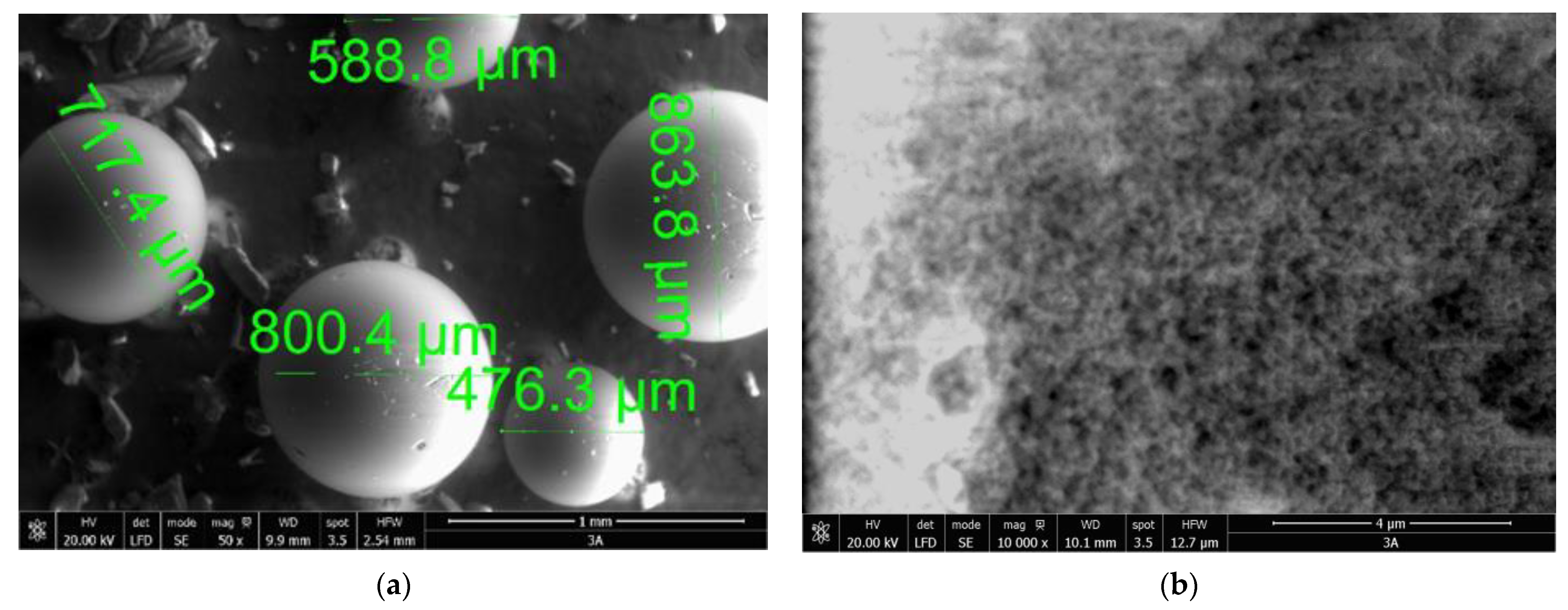
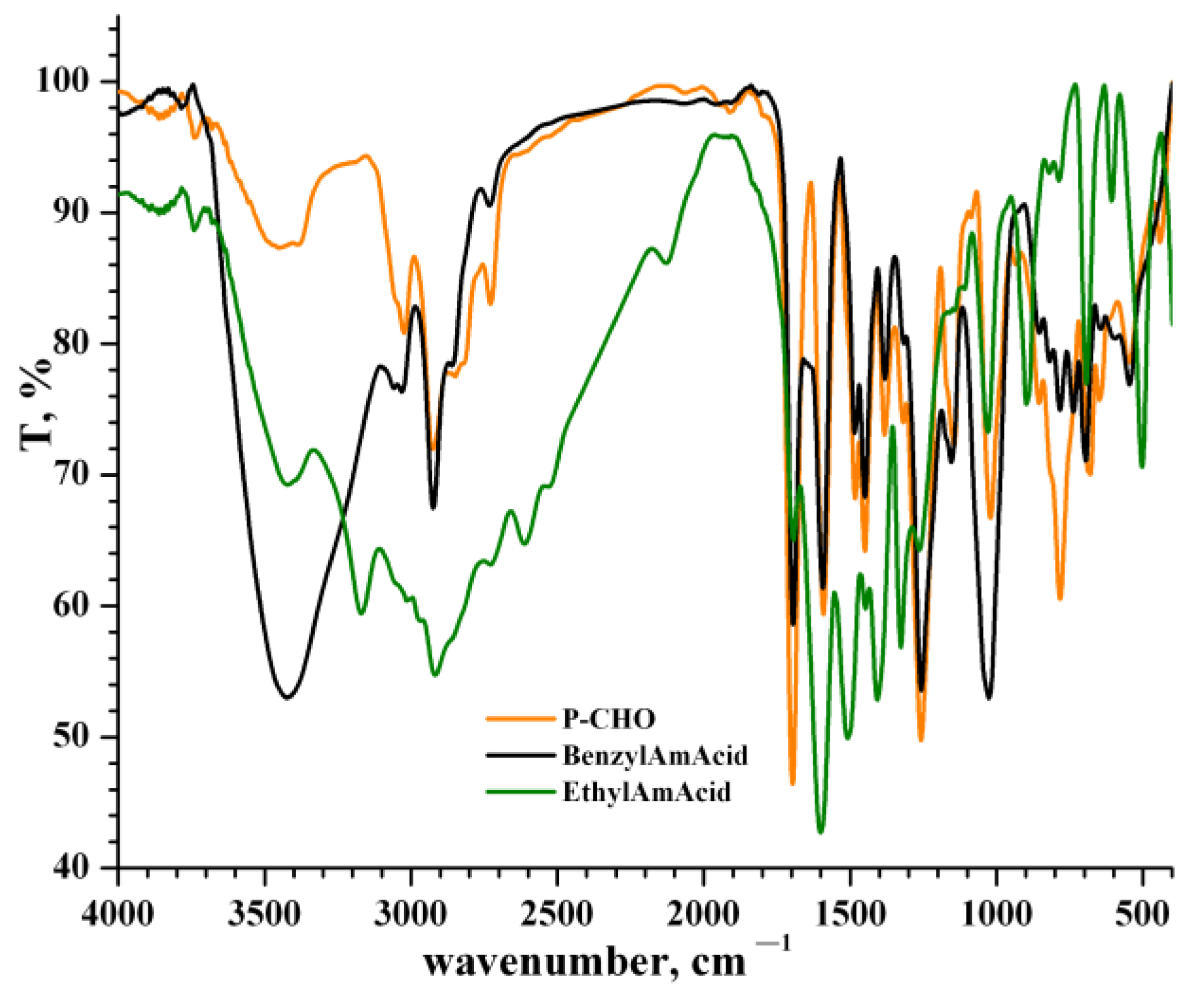
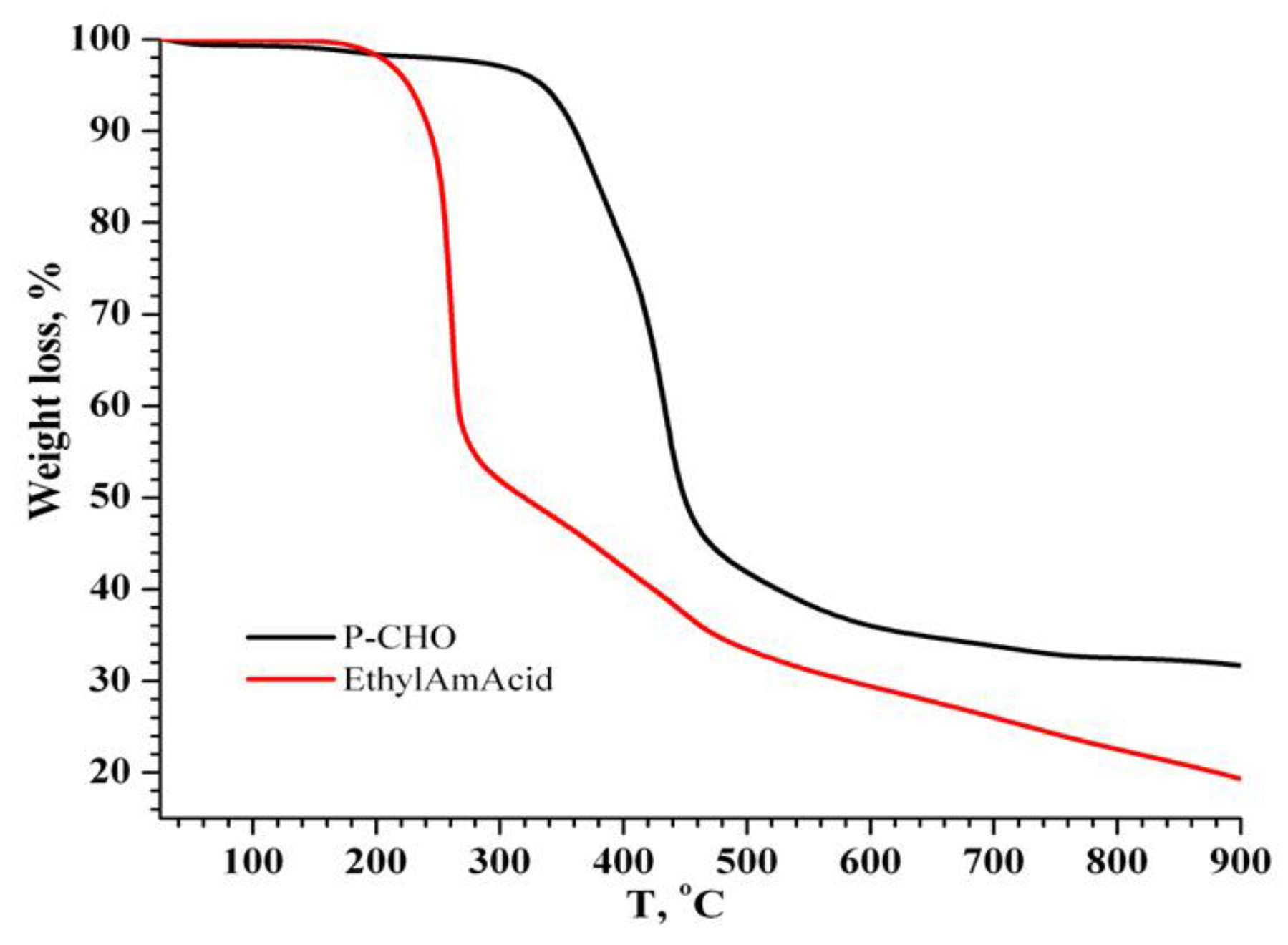

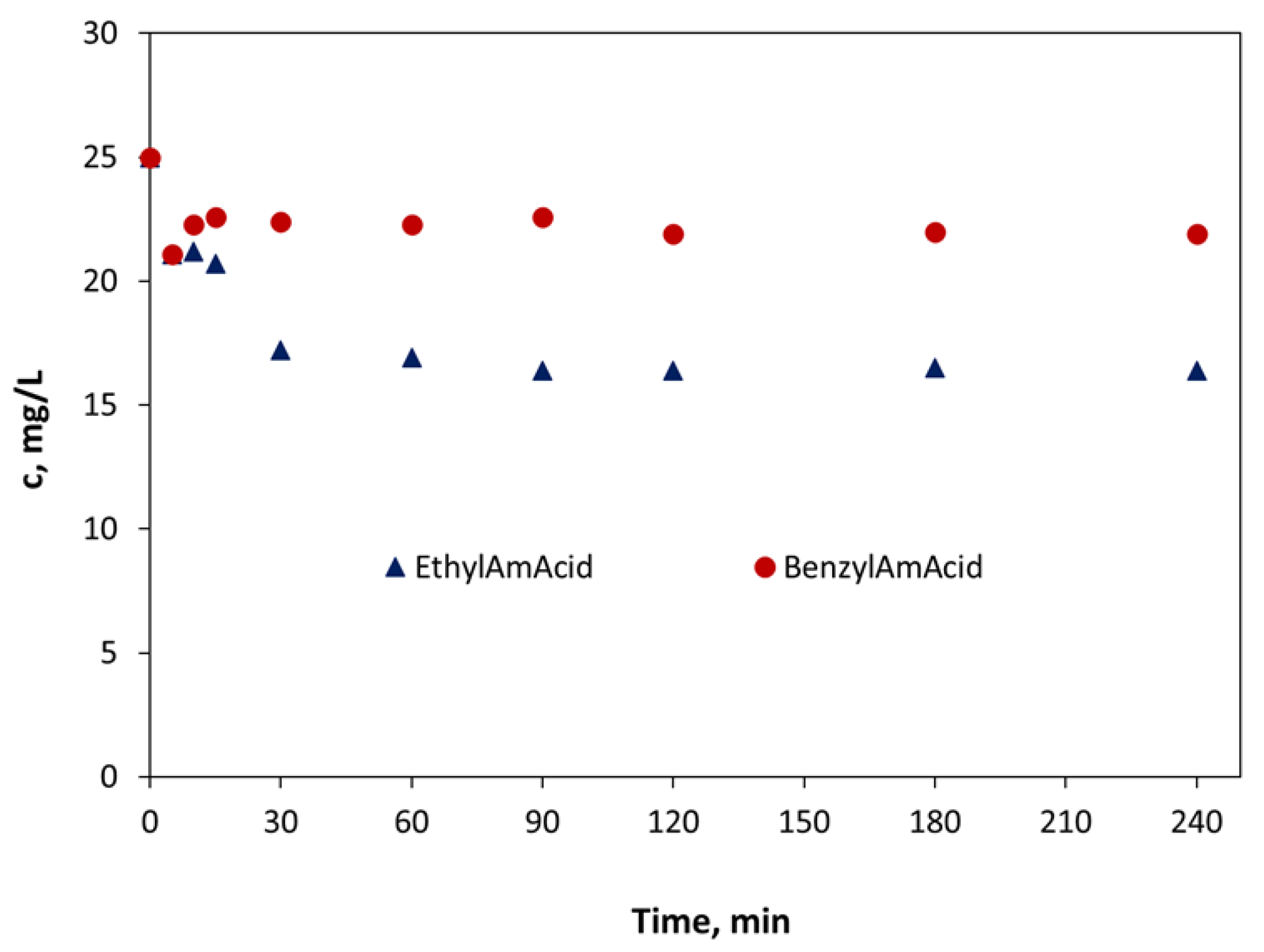
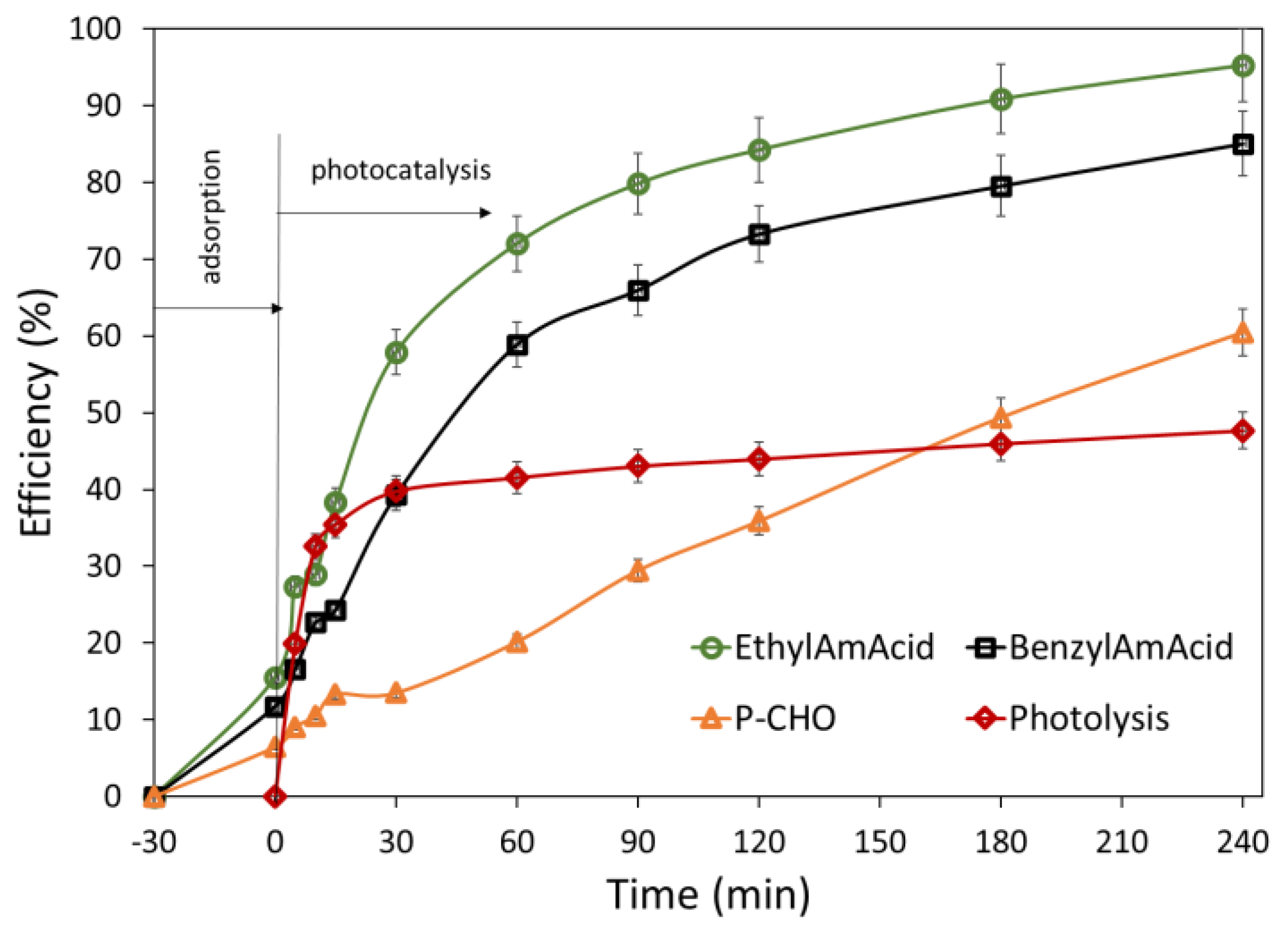
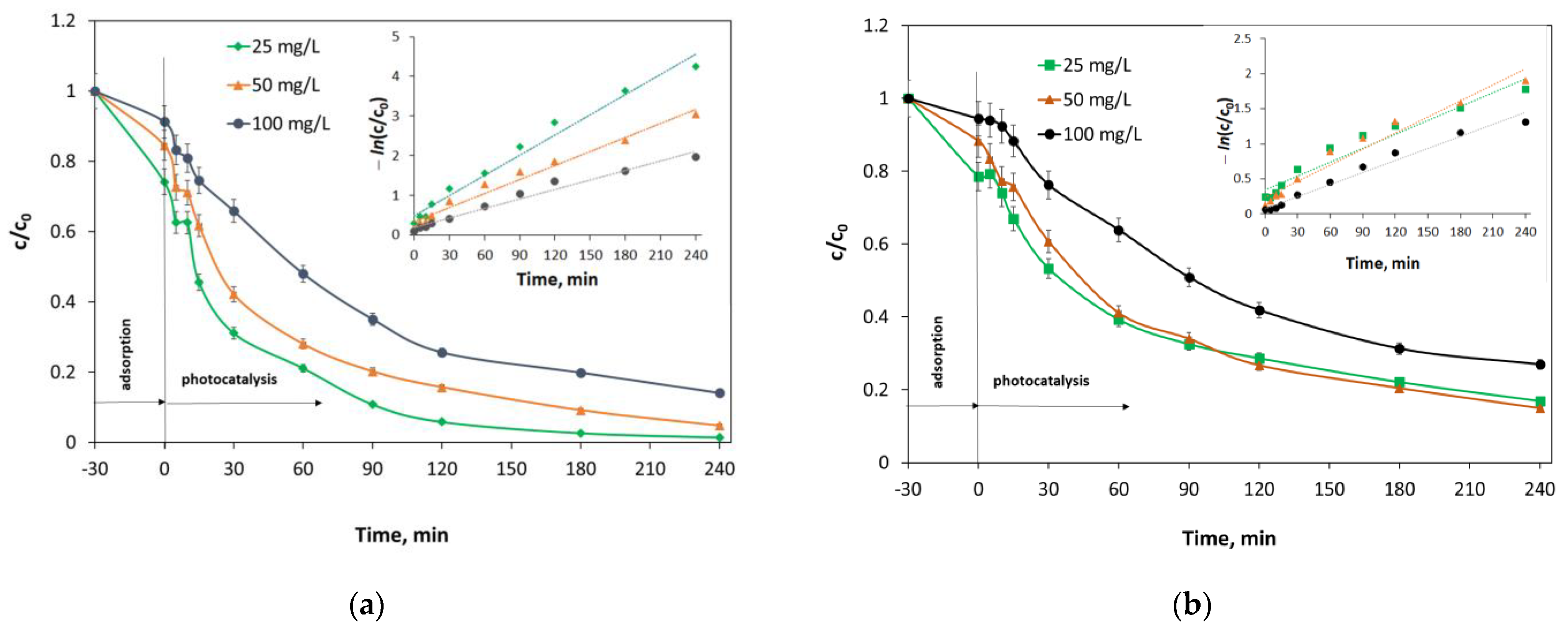

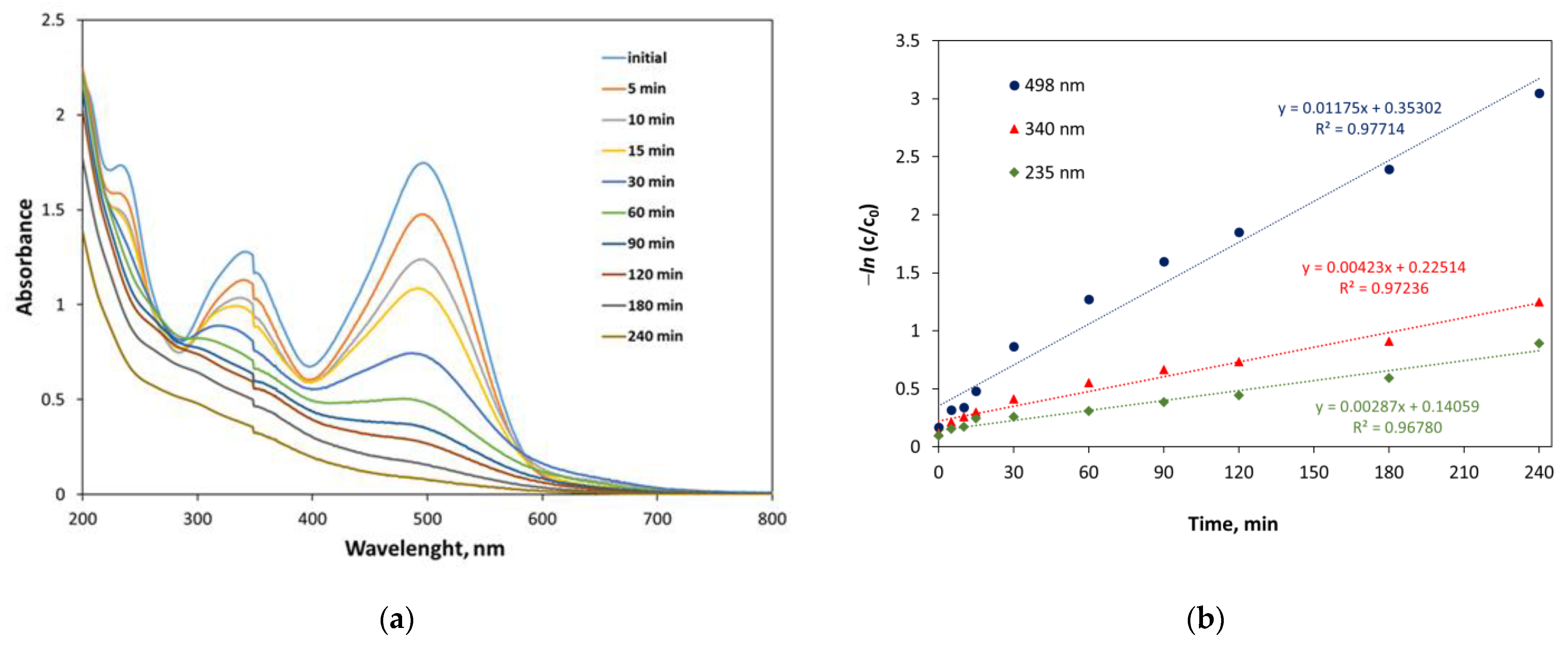
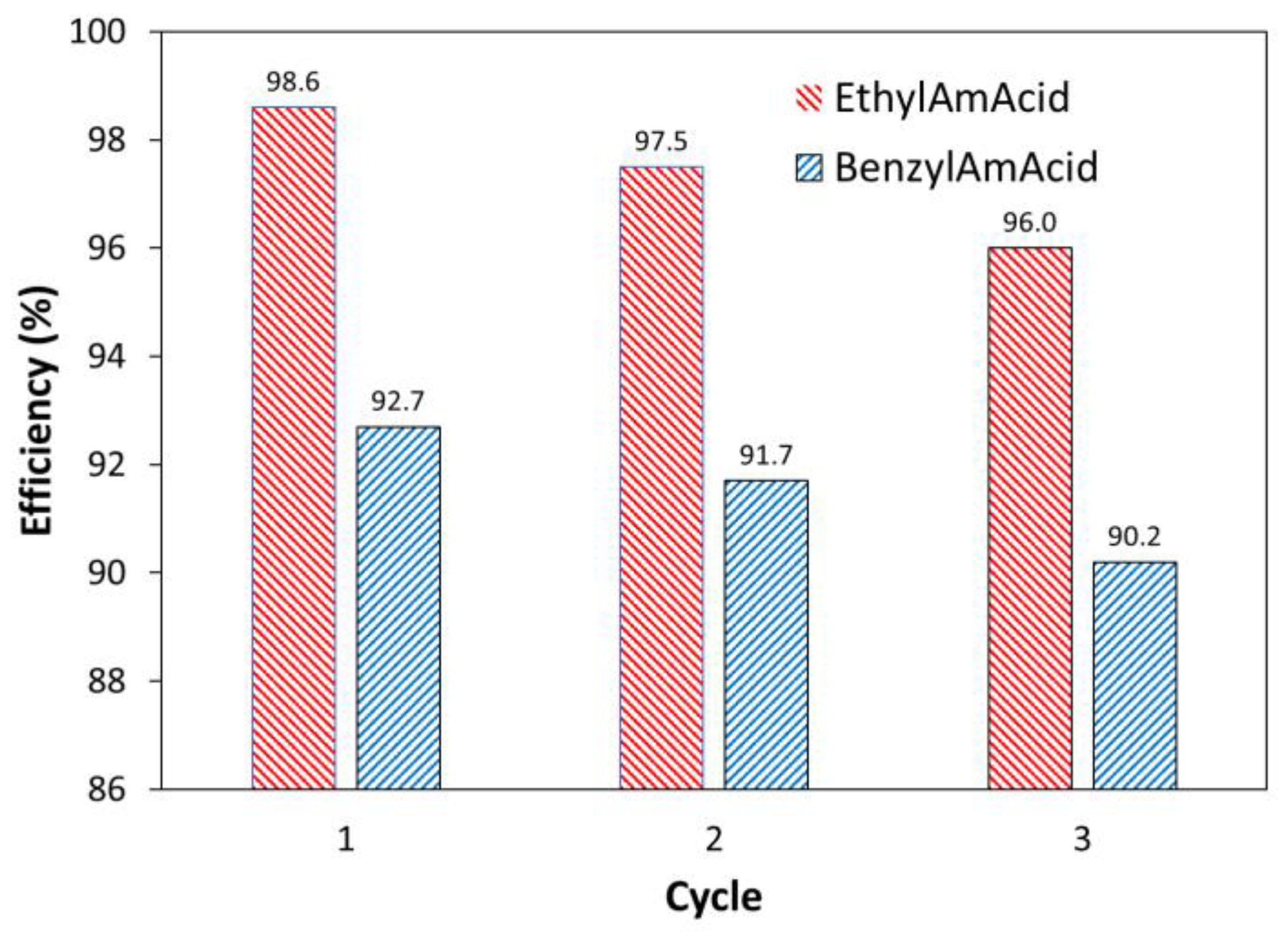
| Elem./Wt% | EthylAmAcid Sample | BenzylAmAcid Sample |
|---|---|---|
| C | 72.1 | 80.5 |
| N | 4.55 | 2.24 |
| O | 21.7 | 16.1 |
| P | 1.51 | 1.11 |
| Cl | 0.141 | 0.0103 |
| Material | c0 (mg/L) | Solid:Liquid (g/L) | Efficiency (%) | kapp·102 (min−1) | R2 |
|---|---|---|---|---|---|
| EthylAmAcid | 25 | 1 | 98.6 | 1.69 | 0.9796 |
| 50 | 1 | 95.3 | 1.18 | 0.9771 | |
| 100 | 1 | 86.0 | 0.802 | 0.9737 | |
| 50 | 0.5 | 93.1 | 1.01 | 0.9774 | |
| 50 | 2 | 92.2 | 1.00 | 0.9608 | |
| BenzylAmAcid | 25 | 1 | 83.1 | 0.661 | 0.9430 |
| 50 | 1 | 85.1 | 0.761 | 0.9596 | |
| 100 | 1 | 73.1 | 0.569 | 0.9760 | |
| 50 | 0.5 | 81.2 | 0.533 | 0.9114 | |
| 50 | 2 | 92.7 | 1.09 | 0.9525 |
Disclaimer/Publisher’s Note: The statements, opinions and data contained in all publications are solely those of the individual author(s) and contributor(s) and not of MDPI and/or the editor(s). MDPI and/or the editor(s) disclaim responsibility for any injury to people or property resulting from any ideas, methods, instructions or products referred to in the content. |
© 2023 by the authors. Licensee MDPI, Basel, Switzerland. This article is an open access article distributed under the terms and conditions of the Creative Commons Attribution (CC BY) license (https://creativecommons.org/licenses/by/4.0/).
Share and Cite
Popa, A.; Cocheci, L.; Lupa, L.; Pop, A.; Visa, A. β-Phosphonated Glycine Pendant Groups Grafted on Styrene-6.7% Divinylbenzene Copolymers: Synthesis and Their Application as Photocatalysts. Appl. Sci. 2023, 13, 2025. https://doi.org/10.3390/app13032025
Popa A, Cocheci L, Lupa L, Pop A, Visa A. β-Phosphonated Glycine Pendant Groups Grafted on Styrene-6.7% Divinylbenzene Copolymers: Synthesis and Their Application as Photocatalysts. Applied Sciences. 2023; 13(3):2025. https://doi.org/10.3390/app13032025
Chicago/Turabian StylePopa, Adriana, Laura Cocheci, Lavinia Lupa, Aniela Pop, and Aurelia Visa. 2023. "β-Phosphonated Glycine Pendant Groups Grafted on Styrene-6.7% Divinylbenzene Copolymers: Synthesis and Their Application as Photocatalysts" Applied Sciences 13, no. 3: 2025. https://doi.org/10.3390/app13032025
APA StylePopa, A., Cocheci, L., Lupa, L., Pop, A., & Visa, A. (2023). β-Phosphonated Glycine Pendant Groups Grafted on Styrene-6.7% Divinylbenzene Copolymers: Synthesis and Their Application as Photocatalysts. Applied Sciences, 13(3), 2025. https://doi.org/10.3390/app13032025










